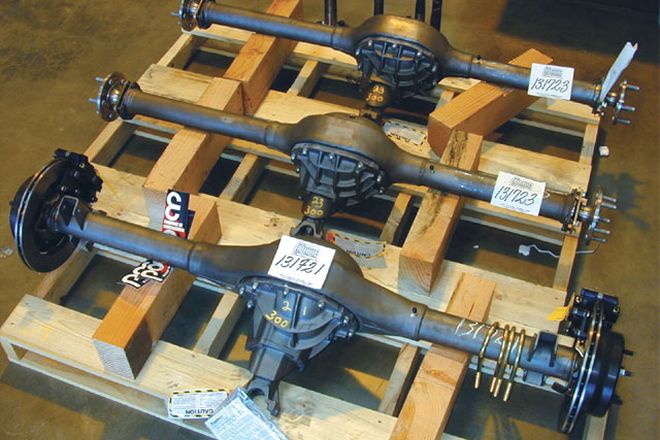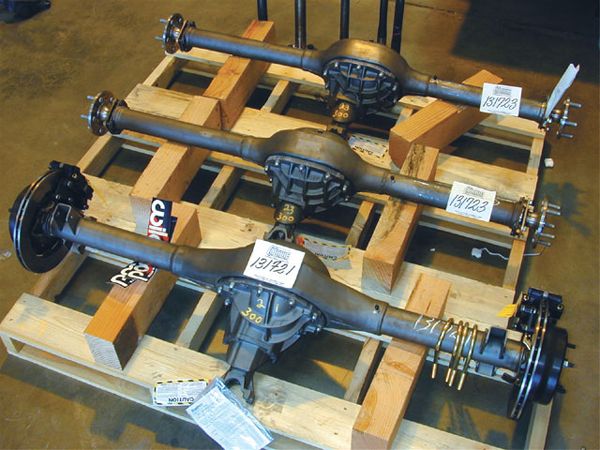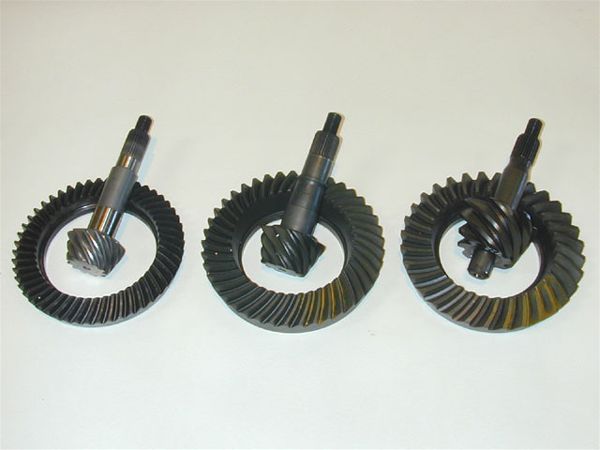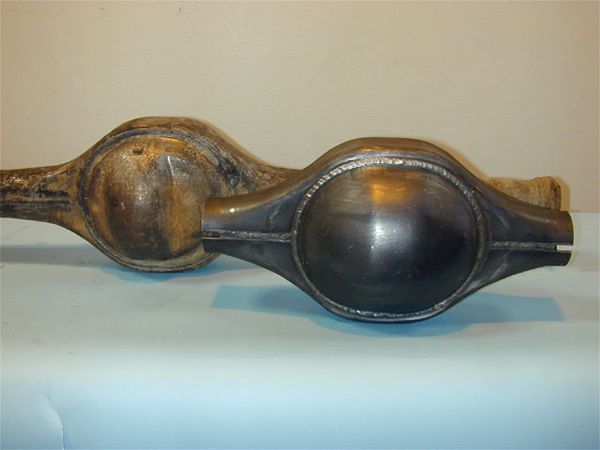
 Drew Hardin
Contributor
Drew Hardin
Contributor
There was a time when the Ford 9-inch axle was synonymous with strength. It was the must-have upgrade, not only for four-wheelers but for hot rodders and drag racers, too. It was plentiful, virtually bulletproof, and it made ring-and-pinion swaps relatively simple, thanks to its drop-out centersection.
Yet during the last few years, the four-wheeling landscape has changed, thanks to the growth of events like competitive rockcrawling and tough-truck-style competitions. Suddenly what used to be strong enough isn't anymore. To tackle the sheer rock faces and treacherous man-made obstacles that would have been considered impassable until recently, a rig must now be equipped with massive tire-and-wheel combinations. (Remember when a 35-inch tire was considered tall?) Suspensions now have to travel through a range of motion that would make a desert racer proud. And a transfer case can't just have standard low-range anymore; it's got to have gears low enough to let a rig walk right up a tree.
Taking the brunt of all this beef are the axles. More unsprung weight, increased operating angles, and higher torque loads all take their toll on the equipment that sends power to the wheels. So in addition to 39.5-inch tires, custom coil-spring suspensions, and 4:1 crawler gears, we're seeing a lot of 1-ton axles-Dana 60s and 70s, GM 14-bolts-under 4x4s that left the factory with 1/2-ton, or lighter, chassis ratings.
And typically, what competitors do to set up their vehicles is imitated by four-wheelers everywhere. So now, even casual 'wheelers are considering hacking up their fenders, doubling up their transfer cases, and building custom axles for a weekend trip to the boonies.

All that stout gear is interesting, but it may be overkill for certain kinds of 'wheeling. Or as Ray Currie of Currie Enterprises put it, "What's used in competition isn't necessarily right for real-world four-wheeling." Now, there's nothing wrong with strength, except for the big hit it puts on your wallet. But consider that you may not need to spend thousands (or tens of thousands) of dollars on a 1-ton axle setup if all you're doing is putt-putting through the woods and climbing the occasional slickrock on the way to your favorite fishing hole.
To Currie, the average four-wheeler doesn't need to emulate the competitive rockcrawlers if he's running tires shorter than 37 or 38 inches, a stock or mildly modified engine, and either a stock or low-geared transfer case, like an Atlas II. This is where our old friend the 9-inch axle comes back into the picture. A 9-inch in the rear of such a vehicle, matched with another 9-inch in front or even a Dana 44 would be just fine-strong, reliable, and not too pricey. "The 9-inch delivers the most strength per dollar," Currie told us. (You can get away with a lighter axle like the Dana 44 in front, Currie told us, since the torque loads on the front axle usually aren't as great as they are on the rear.)
Axle Strength
Before we get into the particulars of modern 9-inch design, let's talk about what makes an axle "weak" or "strong." To begin with, take a look at the photos comparing the relative sizes of the ring-and-pinion gears commonly used in 4x4s. The 9-inch is so named because its ring-gear is 9 inches in diameter. As you can see, it's just plain beefier than a Dana 30 or 44, and also beefier than the GM 10- and 12-bolts. It is also significantly smaller than the ring-gear in a Dana 60. The simple rule of thumb here is, the bigger the ring-gear, the greater its resistance to breaking.
 Ring-gear diameter is one measure of strength, so is ring-gear thickness, and the size of the teeth in the gear. Again, as a general rule, the thinner the ring, or the thinner the teeth, the weaker the gear. These three ring-and-pinion sets-(from L to R) Dana 44, Ford 8.8-inch, and Ford 9-inch-are all about the same diameter. But notice how much stouter the Ford gears are compared with the 44.
Ring-gear diameter is one measure of strength, so is ring-gear thickness, and the size of the teeth in the gear. Again, as a general rule, the thinner the ring, or the thinner the teeth, the weaker the gear. These three ring-and-pinion sets-(from L to R) Dana 44, Ford 8.8-inch, and Ford 9-inch-are all about the same diameter. But notice how much stouter the Ford gears are compared with the 44.
How do you break a ring-gear? Any differential, even a 9-inch, is vulnerable to high torque loads. Send too much power too quickly to the ring-and-pinion and you'll force them apart, which can lead to broken teeth on either or both gears.
To combat that, Ford designed the 9-inch with three pinion support bearings instead of two. An additional pocket bearing, with a retainer built into the gear case, supports the pinion's head and keeps it from twisting away from the ring-gear under torque load. This pocket bearing has been a major contributor to the 9-inch's reputation for being bulletproof.
The other weak link can be in the axles themselves. While the shafts sometimes break, where front axles are concerned it's more often the U-joints and yokes that tie them together that are vulnerable. High torque loads can snap them, as can extreme operating angles. Now, there's nothing inherent in the 9-inch's design that can prevent U-joints from snapping, even in a custom-built 9-inch frontend, but it can easily be upgraded with bigger axleshafts and heavier-duty U-joints.
Spline count is just one component of shaft strength. Probably more important on front axles is the beefiness of the U-joints, where the inner and outer shafts meet, as this will more likely break before the shaft gets sheared. At the bottom is the 297X U-joint from a 3/4-ton truck. This used to be considered heavy-duty equipment before the Super Duty F-450 axles and U-joints (top) began showing up on hard-core rigs. If you're considering going up in spline count, be sure to upgrade the U-joints, too.
High-Pinion
While upgraded axleshafts and U-joints are important parts of strong axles, they are only the tip of the iceberg when it comes to 9-inch modifications. Since the basic 9-inch axle design has been around since the mid-Fifties, engineers have had a lot of time to tinker with it and add their own custom touches to make it better suited to a number of specialized tasks. The reverse-rotation, or high-pinion, 9-inch is a good example. When they were being built by Ford, 9-inch axles were intended to be used as rear axles only. Junkyard shoppers, take note. So those who wanted the strength of a 9-inch in front had to make some changes to the differential's design. The reverse-rotation gearset, which incorporates a ring-gear with a spiral cut in the opposite direction of the standard ring-gear, was born of that process.
As a side benefit for four-wheelers, the pinion in a reverse-rotation axle is positioned higher on the gear case. The pinion in a standard 9-inch sits about 2 1/4 inches below the axle centerline, while the pinion in a reverse-rotation 9-inch is about 1 1/4 inches above the centerline. Those 3 1/2 inches can make a huge difference when you're looking for ground clearance or trying to reduce driveline angles in a short-wheelbase vehicle.
The only downside to a reverse-rotation axle comes when it's used as a rear axle. It can be done, and often is, but driving it against its designed rotation costs the gearset about 20 percent of its strength, according to Currie. For that reason, he considers a 35-inch tire the height threshold for a high-pinion 9-inch being used in the rear. A front-mount high-pinion or a standard 9-inch can safely handle tires up to about 38 inches tall.
The 9-Plus Axle
Individuals scrounging salvage yards for 9-inch axles can still find plenty to choose from (See the accompanying sidebar "Junkyard 9-Inch Tips"), but for a company like Currie, which buys big lots of axles to refurbish, the supply is starting to dwindle. Not only that, but Currie tells us the quality of the 9-inch axles out there is falling. "New 9-inches were last used in cars in 1981, 1986 in trucks. That's 20 years ago. Imagine how beat up these axles are now, especially those coming from the north and east, where they salt the roads," he says.
So Currie decided to manufacture brand-new 9-inch components-housings, axletubes, gear cases, and so on-and called them the 9-Plus line. The "Plus" comes from the fact that, while these assemblies mirror Ford's original design, many of the components are beefier than the originals. The housings, for example, are made from 0.200-inch-wall forming steel, while the wall thickness of a stock 9-inch housing was 1.77 inches. The 9-Plus gear cases are made from nodular iron, while the stock cases were made from what Currie calls "gray steel." The carrier bearings on the gear case are 3.062 inches in diameter, compared to the stock 2.835 inches. There's more material around the pocket bearing, the ribs on the gear case are thicker with bigger feet, and the list goes on.
But in several critical dimensions, the 9-Plus is identical to the standard 9-inch, which means many parts are interchangeable. You can even bolt a 9-Plus gear case to a standard 9-inch housing.
Whether you're thinking about buying a refurbished standard 9-inch or a brand-new 9-Plus, you're looking at a custom setup. "There are so many options available for this axle that we can't really put built 9-inch axles in stock," Currie told us. Instead, his sales team spends a lot of time assessing each customer's needs-what they're driving, how they'll use the rig-and then recommending the right combination of housing, carrier, gear ratio, spline count, traction aid, and so on that best suits the individual vehicle.
Look closely and you can see the differences between the 9-Plus gear case (right) and a refurbished stock 9-inch gear case (left). The reinforcing ribs are thicker, as are the feet where they join the case. There is also more material around the pocket bearing. What you can't see is the case's construction. The stock pieces were made from gray steel, while the 9-Plus cases are made from nodular iron. Ford made nodular iron cases, too, for high-performance applications in the Sixties and Seventies, but they're getting scarce.

Currie Enterprises has begun manufacturing brand-new 9-inch components. These new axle assemblies are called the 9-Plus line, and they're dimensionally identical to stock 9-inches in key areas so you can swap components-ring-and-pinion sets, gear cases, and so on-between them. Here, a stock 9-inch housing sits behind a 9-Plus Heavy Duty housing. The new housings are made from forming steel that is thicker than the original piece, and they will accommodate 3-inch-diameter tubes that can slide into the housing up to 4 inches.
The Bottom Line
Because of the wide array of choices, establishing a price for 9-inch axles is difficult. But since Currie told us the 9-inch represents excellent value, we pressed him on the issue to find out what value actually meant.
To find an answer, he set up price quotes for three different front and rear axle combinations, using similar components in each system, to make it as close to an apples-to-apples comparison as possible. Our subject vehicle would be a hypothetical rockcrawling TJ.
In the rear we chose between a Dana 44, a Currie high-pinion 9-inch, and a reverse-rotation Dana 60. All three would have 4.56 gears, Detroit Lockers, and Explorer disc-brake upgrade kits. Though we tried to make the setups as identical as possible, there were differences. The 60 contained a TeraFlex ring-and-pinion set and 35-spline axleshafts, while the 44 and 9-inch were comparable with 30- and 31-spline axles, respectively. As it turned out, the prices were closer than we imagined. The 44 came in at just over $2,800, the high-pinion 9-inch was pennies under $3,000, and the 60 cost a tick above $3,700.
The differences between front axle assemblies were more pronounced, but that's because we tossed in an additional variable: steering knuckles. Big tires are going to put big stress on the stock steering system, so many hard-core 'wheelers are upgrading their steering with more powerful boxes, hydraulic rams, and other accessories. In this situation, the weak link becomes the steering knuckles. For the ultimate in knuckle beef, you can graft F-450 Super Duty pieces onto your axle, but it'll cost you.
For our imaginary TJ, we asked for three frontends: a reverse rotation Dana 44, a Currie high-pinion 9-inch with 31-spline Spicer outers, and a hybrid with a Currie high-pinion third member matched to a housing that would accommodate the Super Duty knuckles. Again, all three would have 4.56 gears and traction aids, though in this example the first two combinations were fitted with ARBs, while the Super Duty 9-inch had a Detroit Locker. Another difference: The 44 and high-pinion 9-inch had 30- and 31-spline Spicer axles, respectively, while the Super Duty shafts were 35-spline.
Would you be surprised to learn that the Super Duty parts nearly doubled the assembly's price? Here's how it worked out: The Dana 44R cost $4,100, the Currie high-pinion 9-inch was $4,200, and the Super Duty 9-inch went out the door for $6,190, thanks in large part to the $2,300 cost of the Super Duty parts by themselves.
Have we seen the end of upgrades for the 9-inch? Not likely. As long as these axles are popular and plentiful, engineers are bound to continue to mess with them, to bring their strength and durability up even further. Will a seriously beefed 9-inch be able to replace a Dana 60? No. But the seriously beefed 9-inch does present a worthwhile alterna-tive for the 'wheeler who's not ready to move up to 1-ton equipment.
Junkyard 9-Inch Tips
If the prices of the new 9-inch axles mentioned in this story leave you gasping for air, you'll be pleased to learn that there are still plenty of used 9-inch axles to be found in salvage yards all over the country. They're going to be old and grimy, but if you shop carefully, you can find a perfectly serviceable unit for a budget-oriented 4x4.
For tips on buying a used 9-inch, we spoke with Bob Carlisle at Bob's F-100 Parts (909/681-1956). Bob's specialty is classic Ford pickups, not necessarily 4x4s, but he uses dozens of 9-inch axles in his chassis and knows how to rebuild them.
"As long as there's still oil in it and the pinion seal hasn't blown, the axle will be OK," Bob told us. "The 90-weight in the pumpkin is so thick it will coat the gears and keep them from rusting." If the front of the housing is covered in oil, you've got a blown seal. Rust on the external parts shouldn't be an issue, as long as it's just surface rust. Stay way from axlehousings where they coat winter roads in salt.
Keep in mind that 9-inch axles were used under cars and trucks, so pick an assembly that came from a truck for its bigger axles and bolt pattern. Rebuilding a junkyard 9-inch is pretty simple, Bob says. "I pull the axles and open the pumpkin, replace the gaskets, put new seals around the axles and the yoke, and occasionally change bearings. That's about it."
Prices for a salvage 9-inch vary. Bob's experience reflects the Southern California market. "Go to a pick-your-part kind of yard, where you remove the axle yourself, and you can pay as little as $100 or $150. More if the axle has disc brakes." Add a couple hundred dollars if the yard does the removal for you. The most expensive junkyard 9-inch? "The one out of a Lincoln Versailles. Remember it, it looked like a Granada? It's popular with hot rodders because it's narrower and has disc brakes. That'll cost $500-plus," Bob said.
Relative Strength
We asked Ray Currie for a thumbnail sketch of where the most popular 4x4 axles ranked in terms of relative strength.
His list (from weakest to strongest):
Dana 30
Dana 35
AMC 20
Dana 44R*
Dana 44/GM 12-bolt
Currie High-Pinion 9-inch
9-inch
Dana 60R*
Dana 60
Dana 70/GM 14-bolt
R denotes reverse-rotation








